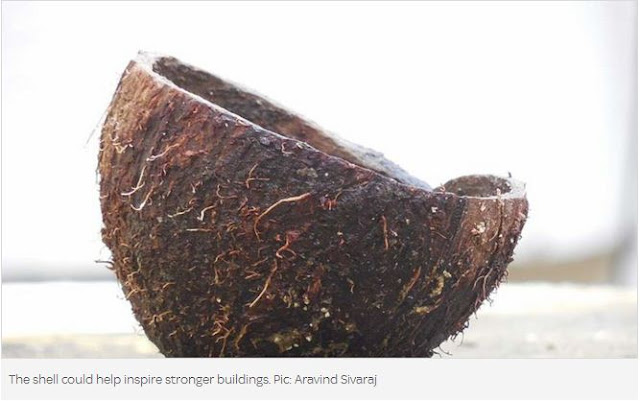Coconuts Inspire Earthquake-Proof Buildings
Earthquake-proof buildings could be created by using concrete which mimics the structure of a coconut shell.
Coconut palms can grow up to 30 metres high, so the
shells of coconuts need to be able to withstand significant impact
without splitting open.
Researchers at the University of Freiburg, Germany, worked with civil engineers and material scientists to analyse the structure of coconuts.
The internal seed is protected by three layers - the skin, the husk and the shell.
 The team found that the inner shell - known as the encocarp -
has a ladder-like vascular system, which transports water and nutrients
around the coconut but is now also thought to help it withstand bending
forces.
The team found that the inner shell - known as the encocarp -
has a ladder-like vascular system, which transports water and nutrients
around the coconut but is now also thought to help it withstand bending
forces.
Plant biomechanist Dr Stefanie Schmier said: "The endocarp seems to dissipate energy via crack deflection.
"This means that any newly developed cracks created by the impact don't run directly through the hard shell."
The research team believes that the design helps to divert the trajectory of cracks: the longer a crack has to travel, the more likely it is to stop growing before getting too big.
They concluded that if textile fibres within concrete are arranged so that they mimic that of the coconut, then it could help to construct buildings which are stronger.
This would be particularly useful in earthquake-prone areas, by making sure that buildings do not crack and topple when the ground starts shaking.
Dr Schmier said: "This combination of lightweight structuring with high energy dissipation capacity is of increasing interest to protect buildings against earthquakes, rock fall and other natural or manmade hazards."
Researchers at the University of Freiburg, Germany, worked with civil engineers and material scientists to analyse the structure of coconuts.
The internal seed is protected by three layers - the skin, the husk and the shell.
The technique could stop buildings from cracking and toppling over
Plant biomechanist Dr Stefanie Schmier said: "The endocarp seems to dissipate energy via crack deflection.
"This means that any newly developed cracks created by the impact don't run directly through the hard shell."
The research team believes that the design helps to divert the trajectory of cracks: the longer a crack has to travel, the more likely it is to stop growing before getting too big.
They concluded that if textile fibres within concrete are arranged so that they mimic that of the coconut, then it could help to construct buildings which are stronger.
This would be particularly useful in earthquake-prone areas, by making sure that buildings do not crack and topple when the ground starts shaking.
Dr Schmier said: "This combination of lightweight structuring with high energy dissipation capacity is of increasing interest to protect buildings against earthquakes, rock fall and other natural or manmade hazards."
Coconuts Inspire Earthquake-Proof Buildings
 Reviewed by Unknown
on
23:30:00
Rating:
Reviewed by Unknown
on
23:30:00
Rating:
 Reviewed by Unknown
on
23:30:00
Rating:
Reviewed by Unknown
on
23:30:00
Rating:





.png)
No comments